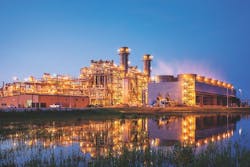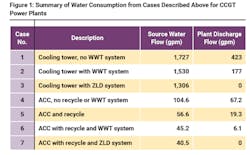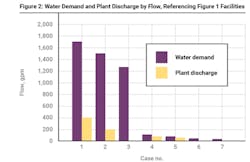About the author:
Brian M. Clarke is manager of water technologies for Kiewit Eng. Group Inc. Clarke can be reached at [email protected].
by Brian M. Clarke
undefinedCombined-cycle gas turbine (CCGT) power plants have emerged as leaders in energy production in the U.S. due to their high efficiencies and lowered emission rates compared to coal-fired power plants. By 2038, CCGT power plants are expected to make up over 50% of the U.S. power production market. Due to their ability to rapidly start-up and provide peaking capacity, CCGT power plants will bridge the gap between energy supply and demand during fluctuations in renewable energy production until battery storage technologies are deployed in greater numbers.
CCGT power plants tend to utilize large amounts of water for cooling and steam generation. Water regulations in the U.S. have become increasingly stringent in recent years, restricting water discharge and limiting intake volume. As water resources become scarcer, public utility rates are likely to increase. This has driven an increased interest in limiting water usage and discharge.
The biggest water user in modern power plants is the wet-cooling system, which uses large volumes of water to condense the steam exiting the steam turbine. For locations where water sources are limited, one option for limiting water consumption is making the switch from a wet-cooling system to a dry-cooling system that uses an air-cooled condenser (ACC). Utilizing an ACC at a CCGT power plant can decrease the total plant water consumption by more than 90%. With the lower water consumption, the plant likely will experience higher power consumption and lower plant efficiencies.
Water consumption can be reduced further within power plants through the use of recycle streams. Although some waste streams, such as rejects from demineralized water treatment and oil/water separator effluent, are not of sufficient quality to be recycled without treatment, the evaporative cooler blowdown and heat recovery steam generator (HRSG) blowdown can be chilled, recycled and reused as service water.
In cases where water availability or discharge is more severely restricted, internal recycling can be further enhanced through the use of wastewater treatment (WWT) systems. Adding a WWT system will allow the user to recycle a greater amount of water to the service water tank, thus minimizing the required source water inlet flow rate to the plant. For cases in which a WWT system is implemented, the discharge from the oil/water separator and the first-pass reverse osmosis reject are collected in a storage tank before being fed to the WWT system.
The next step in water reuse is implementation of a zero liquid discharge (ZLD) system. With ZLD more complex and costly equipment would be added to the traditional WWT system. The water recycle rate would be increased to approximately 100% while the dissolved solids that enter the system concentrate, precipitate and are trucked off-site. ZLD systems are the most extreme option for water conservation because they represent not only an increased equipment cost, but also increased power consumption and operating cost as well.
Seven possible water treatment configurations for CCGT power plants were evaluated to show the variation in water consumption and discharge. All of the configurations utilize a single combustion turbine generator with an evaporative cooler, and a heat recovery steam generator unit. The evaporative coolers are operated at four cycles of concentration, as are the cooling towers, in the cases where plants utilize cooling towers. The plant gross output is about 500 MW. The flows estimated in the section to the left (see Figure 1) represent the average of multiple cases, including summer, winter, fall and spring.
Figure 1 demonstrates the trend in water use between CCGT plants that use cooling towers and those that use an ACC, and also the impact that recycle loops and WWT systems can have on water intake and outfall flow rates. Discharge versus water demand can be seen in Figure 2.
As Figure 1 illustrates, the most dramatic reductions in water consumption are seen when switching from a cooling tower to an ACC. It is important to note that water consumption is not the only consideration that should be taken into account when selecting a CCGT power plant design scheme. Capital cost, utility demand and cost, source water cost, and permitting requirements also should be evaluated, but there are situations where decisions for water reuse and treatment are dictated more by necessity than by economic incentive.


